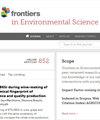利用氧化石墨烯去除水溶液中的诺氟沙星和头孢曲松抗生素:采用响应面法优化工艺
IF 3.3
3区 环境科学与生态学
Q2 ENVIRONMENTAL SCIENCES
引用次数: 0
摘要
本研究使用氧化石墨烯(GO)作为吸附剂来去除水溶液中的诺氟沙星和头孢曲松抗生素。在不连续系统中,对所有影响去除的环境因素(如 pH 值、吸附剂质量、接触时间和浓度)进行了优化。实验设计和变量优化采用响应面法(RSM)进行。方差分析(ANOVA)和二次项回归系数的结果表明,反应受到所有研究变量的显著影响(P < 0.05)。同时,二次多项式模型结果与经验数据相符,具有较高的决定系数(即两种抗生素的 R2 ˃ 0.99)。此外,调整后的 R2(两种抗生素的 R2-adj ˃0.98)也接近 R2 值,表明这是一个良好的、可接受的统计模型。结果表明,在 pH 值为 8、吸附剂质量为 0.034 克、超声时间为 20 分钟、浓度为 25 毫克/升的条件下,GO 对抗生素的去除效果最佳。在这些条件下,头孢曲松和诺氟沙星的最大去除率分别为 95.87% 和 98.64%。在五个吸附/解吸过程中,GO 都得到了回收,在使用该吸附剂五个周期后,去除率略有下降。因此,可以得出结论:GO 是一种从水环境中去除头孢曲松和诺氟沙星的高效、可接受的吸附剂。本文章由计算机程序翻译,如有差异,请以英文原文为准。
Use of graphene oxide for the removal of norfloxacin and ceftriaxone antibiotics from aqueous solution: process optimization using response surface approach
In this research, graphene oxide (GO) as an adsorbent was used to remove norfloxacin and ceftriaxone antibiotics from aqueous solutions. All environmental factors affecting removal (e.g., pH, adsorbent mass, contact time, and concentration) were optimized in a discontinuous system. The design of experiments and the optimization of variables were carried out using the response surface method (RSM). The results of the analysis of variance (ANOVA) and the regression coefficients of the quadratic terms indicated that the responses were significantly affected by all the studied variables (P < 0.05). Also, the quadratic polynomial model results corresponded to empirical data with a high coefficient of determination (i.e., R2 ˃ 0.99 for both antibiotics). Besides, the adjusted R2 (R2 -adj ˃ 0.98 for both antibiotics) was close to R2 values, indicating a good and acceptable statistical model. According to the results, the optimal removal of antibiotics by GO occurs in conditions of pH of 8, 0.034 g of the adsorbent mass, a sonication time of 20 min, and a concentration of 25 mg L−1 . In these conditions, the maximum removal efficiencies of ceftriaxone and norfloxacin were equal to 95.87% and 98.64%, respectively. GO was recovered in five adsorption/desorption processes, and the removal efficiency declined very slightly after using the adsorbent for five cycles. Therefore, it is concluded that GO is an efficient and acceptable adsorbent for removing ceftriaxone and norfloxacin from aqueous environments.
求助全文
通过发布文献求助,成功后即可免费获取论文全文。
去求助
来源期刊

Frontiers in Environmental Science
Environmental Science-General Environmental Science
CiteScore
4.50
自引率
8.70%
发文量
2276
审稿时长
12 weeks
期刊介绍:
Our natural world is experiencing a state of rapid change unprecedented in the presence of humans. The changes affect virtually all physical, chemical and biological systems on Earth. The interaction of these systems leads to tipping points, feedbacks and amplification of effects. In virtually all cases, the causes of environmental change can be traced to human activity through either direct interventions as a consequence of pollution, or through global warming from greenhouse case emissions. Well-formulated and internationally-relevant policies to mitigate the change, or adapt to the consequences, that will ensure our ability to thrive in the coming decades are badly needed. Without proper understanding of the processes involved, and deep understanding of the likely impacts of bad decisions or inaction, the security of food, water and energy is a risk. Left unchecked shortages of these basic commodities will lead to migration, global geopolitical tension and conflict. This represents the major challenge of our time. We are the first generation to appreciate the problem and we will be judged in future by our ability to determine and take the action necessary. Appropriate knowledge of the condition of our natural world, appreciation of the changes occurring, and predictions of how the future will develop are requisite to the definition and implementation of solutions.
Frontiers in Environmental Science publishes research at the cutting edge of knowledge of our natural world and its various intersections with society. It bridges between the identification and measurement of change, comprehension of the processes responsible, and the measures needed to reduce their impact. Its aim is to assist the formulation of policies, by offering sound scientific evidence on environmental science, that will lead to a more inhabitable and sustainable world for the generations to come.
 求助内容:
求助内容: 应助结果提醒方式:
应助结果提醒方式:


